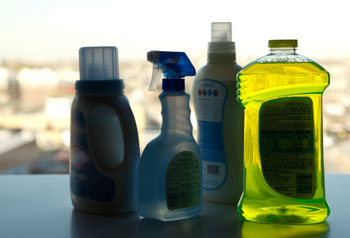Controlling Asthma Triggers in Your Environment
Controlling Asthma Triggers in Your Environment
An important part of managing asthma is controlling triggers. These are things that make symptoms worse or that cause flare-ups. Triggers may be anywhere, inside or out. Indoor triggers may be at home, work, school, day care, and other places. It is impossible to completely get rid of triggers. But there are some things you can do to control them.

At home
Here are some things you can do at home:
-
Don’t let anyone smoke. Even if they smoke outside, it may still work its way inside. The smoke that they bring in on their clothes (third-hand smoke) can also cause asthma symptoms.
-
Keep windows closed to keep humid air outside. Use fans in the kitchen and bathroom.
-
Don’t use fireplaces or wood stoves. Make sure all appliances are properly vented to the outside.
-
Don’t use strong smelling products. For example, cleaning products, air fresheners, potpourri, candles, and incense.
-
Keep your home as clean as possible. Try to remove all the clutter.
-
If you have pets, keep them off your bed and out of your bedroom.
-
Use air cleaners and vacuums designed to remove allergens. Change filters often. This includes furnace filters, too.
At work
Here are some things you can do at work:
-
If your workplace is smoke-free, stay away from any smoking areas. If it is not smoke-free, think about talking to your manager.
-
If you notice that your symptoms get worse at work, talk with your healthcare provider. Together you can figure out the trigger.
-
Fumes, dust, or chemicals may be triggers. If you know the cause, it is possible that it can be removed. For example, if certain cleaning products trigger your asthma, your company may be able to use different ones.
-
You may be able to change your work situation to lessen your exposure to triggers. Working at another location or from home, or working different hours (when there are less fumes, for example), are all options.
-
The Americans with Disabilities Act (ADA) may also help you and your employer. ADA Information Line: 800-514-0301 (Voice): 800-514-0383 (TTY).
-
Poor airflow or ventilation may be a problem. The Occupational Safety and Health Administration (OSHA) and the National Institute for Occupational Safety (NIOSH) have information that can help:
At school or daycare
Here are some things you can do at school or daycare:
-
Make sure school or daycare is smoke-free. If teachers or other employees smoke, the smoke on their bodies and clothes may trigger symptoms in your child.
-
Look around to see if the rooms are clean. Bathrooms and locker rooms shouldn’t have a lot of moisture.
-
Ask about sources of dust in the classroom. There may be carpeting, pillows, rugs, and stuffed animals.
-
Ask about furry pets in the classroom. Some classes have pet rabbits, guinea pigs, or hamsters.
-
Make sure your child keeps away from buses or vans while outside during drop-off and pickup times. The exhaust can trigger symptoms.
-
Ask about strong smelling supplies. There may be arts and crafts and cleaning products with strong odors.
-
Make sure your child washes his or her hands after playing outside to remove allergens. If your child has seasonal allergies, ask that he or she stay indoors when allergen counts are high.
-
The Americans with Disabilities Act (ADA) and Section 504 of the Civil Rights Act may provide more information and clarification for both parents and school officials. Call 800-USA-LEARN (800-872-5327).
Updated:
August 14, 2018
Reviewed By:
Alan J Blaivas DO,Amy Finke RN BSN,Daphne Pierce-Smith RN MSN CCRC